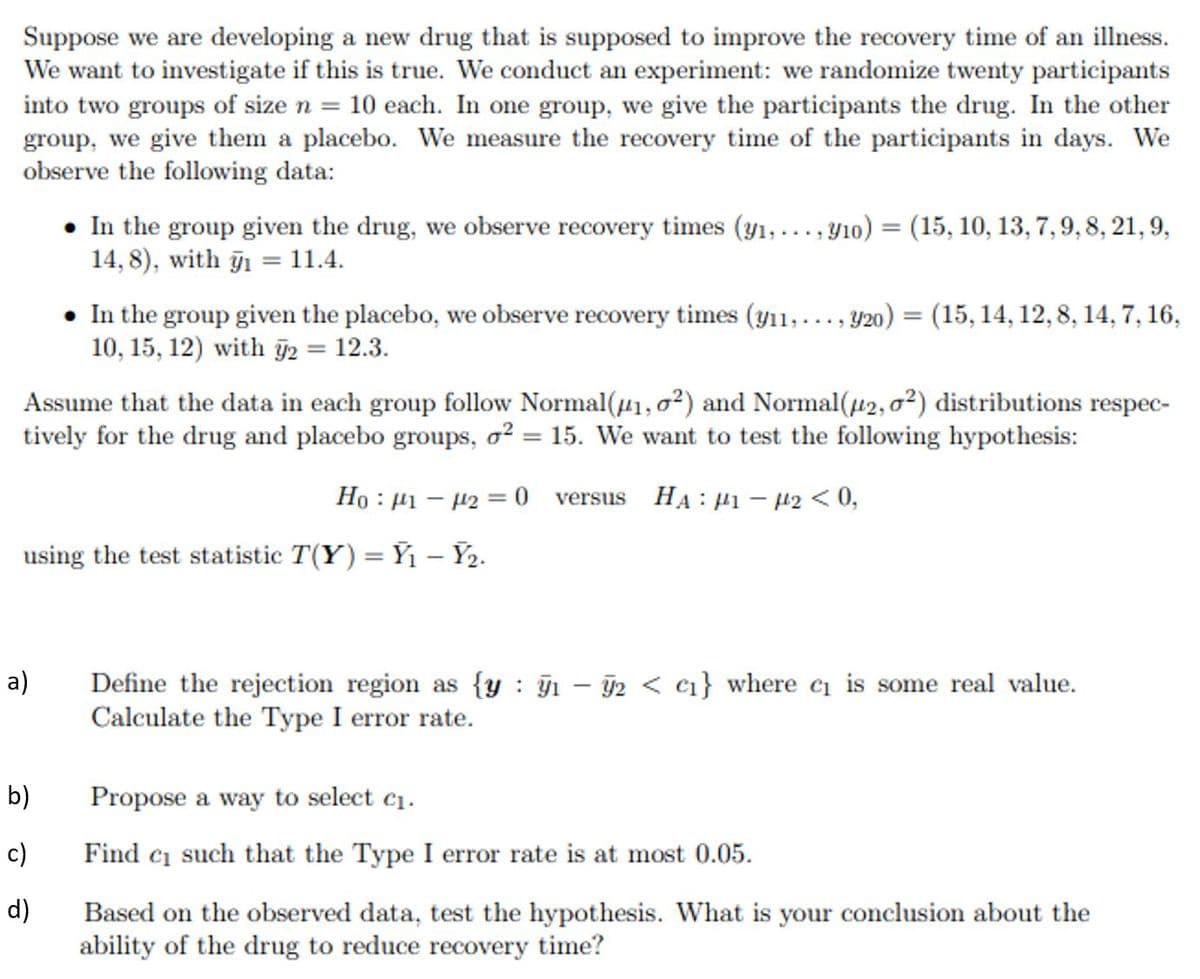Define the rejection region as {y : ı – 2 < ci} where c is some real value. a) Calculate the Type I error rate. b) Propose a way to select c1. c) Find ei such that the Type I error rate is at most 0.05. d) Based on the observed data, test the hypothesis. What is your conclusion about the ability of the drug to reduce recovery time?
Define the rejection region as {y : ı – 2 < ci} where c is some real value. a) Calculate the Type I error rate. b) Propose a way to select c1. c) Find ei such that the Type I error rate is at most 0.05. d) Based on the observed data, test the hypothesis. What is your conclusion about the ability of the drug to reduce recovery time?
Holt Mcdougal Larson Pre-algebra: Student Edition 2012
1st Edition
ISBN:9780547587776
Author:HOLT MCDOUGAL
Publisher:HOLT MCDOUGAL
Chapter11: Data Analysis And Probability
Section: Chapter Questions
Problem 8CR
Related questions
Concept explainers
Equations and Inequations
Equations and inequalities describe the relationship between two mathematical expressions.
Linear Functions
A linear function can just be a constant, or it can be the constant multiplied with the variable like x or y. If the variables are of the form, x2, x1/2 or y2 it is not linear. The exponent over the variables should always be 1.
Question
solve c and d only

Transcribed Image Text:Suppose we are developing a new drug that is supposed to improve the recovery time of an illness.
We want to investigate if this is true. We conduct an experiment: we randomize twenty participants
into two groups of size n = 10 each. In one group, we give the participants the drug. In the other
group, we give them a placebo. We measure the recovery time of the participants in days. We
observe the following data:
• In the group given the drug, we observe recovery times (yı,..., Y10) = (15, 10, 13, 7,9, 8, 21,9,
14, 8), with ĝ1 = 11.4.
• In the group given the placebo, we observe recovery times (yı1,..., Y20) = (15, 14, 12, 8, 14, 7, 16,
10, 15, 12) with j2 = 12.3.
Assume that the data in each group follow Normal(µ1,0²) and Normal(42, o²) distributions respec-
tively for the drug and placebo groups, o2
15. We want to test the following hypothesis:
Ho : µ1 – 12 = 0 versus HA: µ1 – 42 < 0,
using the test statistic T(Y) = Y1 – Ý2.
a)
Define the rejection region as {y : ĝı – 2 < c1} where ci is some real value.
Calculate the Type I error rate.
b)
Propose a way to select c1.
c)
Find ci such that the Type I error rate is at most 0.05.
d)
Based on the observed data, test the hypothesis. What is your conclusion about the
ability of the drug to reduce recovery time?
Expert Solution
This question has been solved!
Explore an expertly crafted, step-by-step solution for a thorough understanding of key concepts.
Step by step
Solved in 3 steps

Knowledge Booster
Learn more about
Need a deep-dive on the concept behind this application? Look no further. Learn more about this topic, statistics and related others by exploring similar questions and additional content below.Recommended textbooks for you

Holt Mcdougal Larson Pre-algebra: Student Edition…
Algebra
ISBN:
9780547587776
Author:
HOLT MCDOUGAL
Publisher:
HOLT MCDOUGAL

College Algebra
Algebra
ISBN:
9781305115545
Author:
James Stewart, Lothar Redlin, Saleem Watson
Publisher:
Cengage Learning

Holt Mcdougal Larson Pre-algebra: Student Edition…
Algebra
ISBN:
9780547587776
Author:
HOLT MCDOUGAL
Publisher:
HOLT MCDOUGAL

College Algebra
Algebra
ISBN:
9781305115545
Author:
James Stewart, Lothar Redlin, Saleem Watson
Publisher:
Cengage Learning